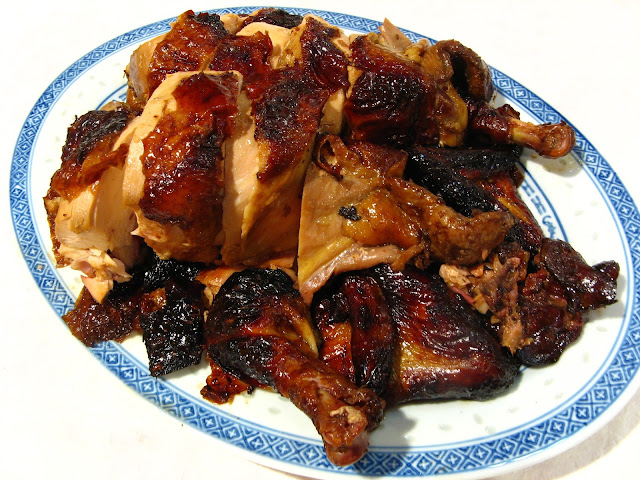
This is my version of tea smoked chicken using a marinated whole
chicken and an outdoor barbeque grill. Any fragrant tea can be used for
smoking, I happen to use oolong tea leaves. Tea smoking is usually associated
with duck and done indoors in a covered wok, but chicken works just as well. In
this case I used a whole chicken, but you can just as easily substitute chicken
parts for the whole. I use my outdoor barbeque grill to cook the chicken because
it’s so much easier (no cleanup) and the house doesn’t end up smelling of smoke
(despite a good ventilation system over the stove). The traditional recipe for
this dish has the unmarinated chicken (or duck) first steamed, then smoked, and
then deep fried. When you eat this dish at a restaurant, that’s probably the
way the dish was prepared, since the chicken or duck can be steamed well before
being ordered, and then quickly smoked and deep fried before being served. The
end result is a crispy tea smoked chicken or duck with succulent flesh.
My grilled version of tea smoked chicken doesn’t have the
crispy skin that you find in the restaurant dish, but cooking the chicken is so
much easier. The same ingredients used to tea smoke the traditional dish are
used in the grilled version, except for the sugar. Sugar is one of the
ingredients (amongst others) used in a foil packet to tea smoke the chicken. When
a chicken or duck is tea smoked indoors in a wok, sugar can be used because of
the short amount of time (maybe 10 minutes) needed to smoke the cooked chicken.
Since I cook and tea smoke my chicken in a barbeque grill, the time needed to
both cook and smoke the chicken is much longer (30-40 minutes), so the sugar burns
and make the smoke acrid. So I leave the sugar out of the tea smoking
ingredients when I use the grill.
I used a basic soy sauce marinade to grill the whole
chicken. I put the chicken on a “beer can” stand to roast it upright in the
barbeque. While I didn’t use a beer can to keep the chicken upright, I have an
apparatus that has two rods attached to a pan that keeps the chicken standing
while being grilled. The standing chicken is placed in the charcoal grate,
without using the grill grate. The barbeque cover can’t be used if the standing
chicken is placed on the grill grate in a 22.5 in. (57 cm.) barbeque grill, so
that’s why the standing chicken is placed on the charcoal grate with the coals arranged
around it in a circle.
Enjoy!



















